Welcome back to the How To Play Magic: The Gathering series from Star City Games. If you missed the first installment covering the basics, you can find that below.
Today, we’ll be going over card types. Get ready to learn all about creatures, lands, artifacts and enchantments, instants, sorceries and planeswalkers.
Permanents and Non-Permanents
There are many different card types in Magic. Broadly speaking, Magic cards break down into one of two categories, permanents and non-permanents. “Permanent” describes any card you play that stays on the battlefield until it is killed or destroyed. Permanents include lands, creatures, enchantments, artifacts and planeswalkers.
Non-permanents are one-time-use spells that go to the graveyard after you cast them. These types of spells are instants and sorceries.
The Type Line
You can figure out what any card is by reading the type line. The first line of the card has the card’s name in the top left, and its mana cost in the top right. The middle line has the card’s type and expansion symbol. The first word in the type line tells you what kind of card it is. A creature will say “Creature” followed by the subtype of creature it is.

Let’s look at Walking Corpse. As you can see in the top left, this card is named Walking Corpse and its mana cost is one generic mana and one black mana (often shortened to “one and a black” or “one black”). Remember from “The Basics” that this means it requires two total mana to cast, one from a Swamp and another from any other source. It is a creature, and its creature subtype is Zombie. The expansion symbol shows you it was printed in Core Set 2021.
The Bottom Half
The bottom half of a card consists of the card’s text box, where you’ll find any ability or effect the card has. If the card is a creature, it will have its power and toughness in the bottom right. Walking Corpse has two power and two toughness. Power and toughness are often shortened to just the numbers when playing, so Walking Corpse would be called a 2/2.
Creatures
Creatures come in all shapes and sizes in Magic. Let’s compare Walking Corpse with Serra Angel. Serra Angel costs three generic mana and two white mana (“three and two white” or “three white white”), is an Angel creature, has flying and vigilance, and is a 4/4.
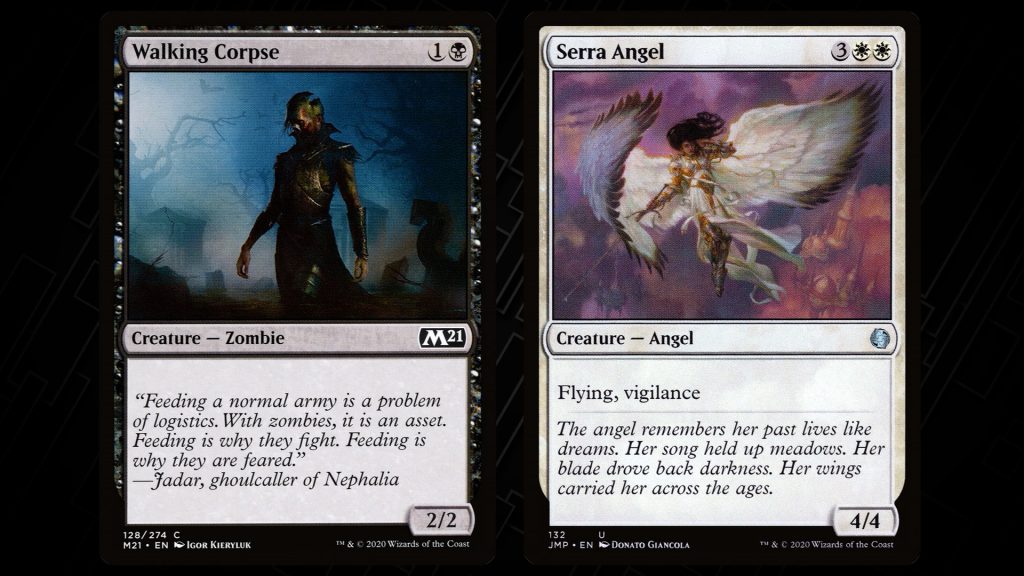
Creatures will all look similar, with their main differences being casting cost, type, ability, and power and toughness. Creatures are the primary way you reduce your opponent’s life total to zero, as they can stay on the battlefield and deal damage for multiple turns.
Lands
Next up, we’ll look at lands. You’ll note the casting cost of the two creatures so far included one black and three white white. Lands produce mana that help you cast your spells. Let’s start with basic lands. Basic lands have names in the top left like all other cards. The five basic lands found in all sets are Plains, Island, Swamp, Mountain, and Forest. Lands don’t have mana cost because they are free to play.
On each of your turns, you can play one land. You can use a land to make one mana of a corresponding color by tapping it once each turn. Plains make white mana, Islands make blue mana, Swamps make black mana, Mountains make red mana, and Forests make green mana. Basic lands are the one type of card you can have more than four copies of in a deck.
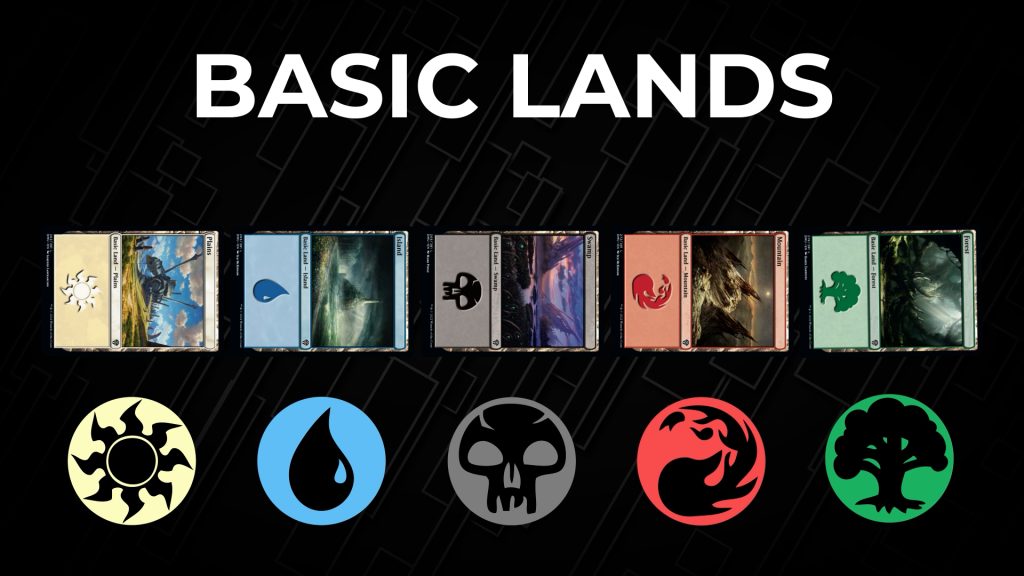
There are many other kinds of lands in Magic as well, called “nonbasic” since they aren’t basic lands. Almost all of them tap for mana, but some have additional abilities or can create multiple colors of mana. Take a look at some varieties of nonbasic lands. Tranquil Cove and Rugged Highlands can make one of two different colors of mana, white or blue and red or green.
Ketria Triome and Raugrin Triome can make one of three different colors of mana, green, blue, or red and blue, red, or white. They have an extra ability called cycling, but have a downside of entering the battlefield tapped, meaning you can’t produce mana with them on the first turn they are played.
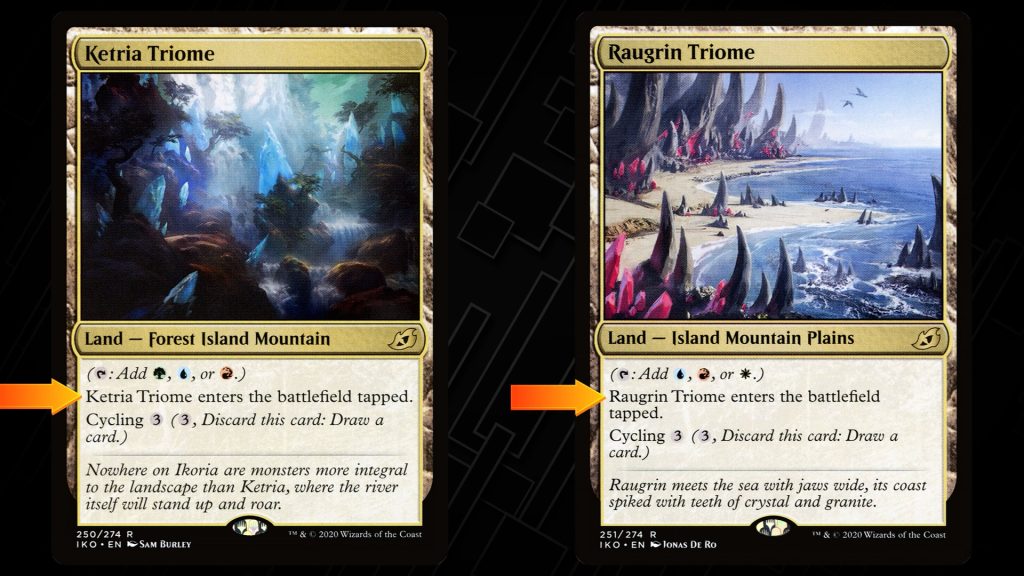
Animal Sanctuary doesn’t produce colored mana, only colorless mana, and has an additional activated ability that can buff some of your creatures. Memorial to Genius makes blue mana and also has the ability to trade it in to draw two cards later in the game. There are hundreds of nonbasic lands in Magic that give you plenty of options to play alongside your basic lands.
Enchantments
Next up are enchantments. Enchantments have persistent magical effects that influence the game as long as they’re on the battlefield. There are two types of enchantments, global enchantments and Auras. Global enchantments are played on their own and have broad effects that impact you or your permanents.
Let’s take a look at a couple of global enchantments. Glorious Anthem is a three-mana enchantment that grants your creatures +1/+1. Whirlwind of Thought lets you draw a card whenever you cast a noncreature spell. These enchantments will remain on your side until they are specifically removed from the battlefield.
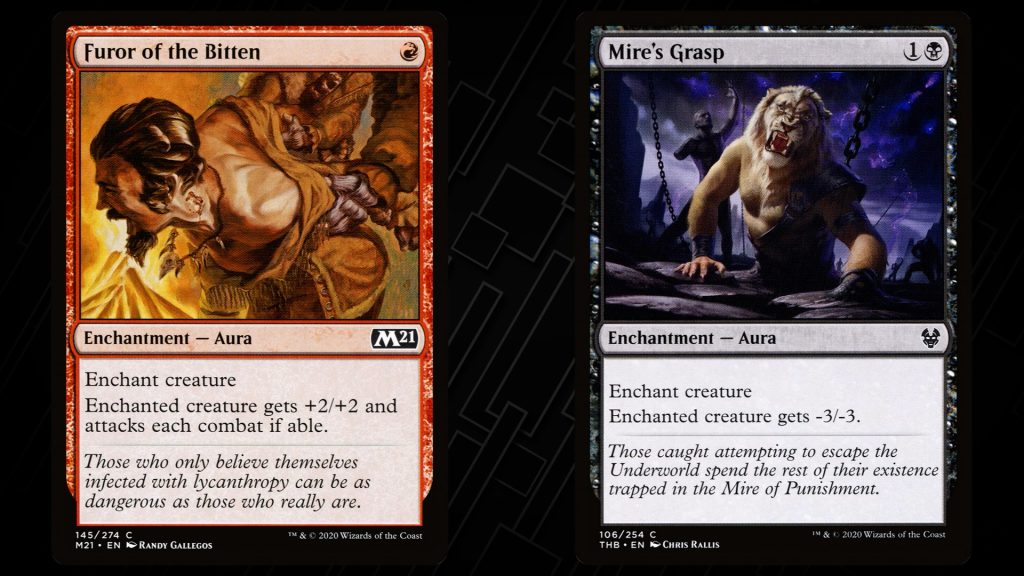
Now let’s look at some Auras. Auras are placed on another permanent, most often creatures and lands, and augment them in certain ways. Notably, Auras can be placed on your own creatures or your opponent’s creatures. You can cast Furor of the Bitten on one of your creatures to make it stronger, with the caveat that it has to attack each turn. Mire’s Grasp is mainly aimed at weakening or killing opposing creatures. That said, there might be a situation where you’ll want to put Furor of the Bitten on an opponent’s creature and Mire’s Grasp on one of your own. Keep an eye out for when those opportunities might present themselves.
If the creature these Auras are enchanting dies, the Aura will also be destroyed and go to the graveyard. If the target of an Aura is destroyed in response to you casting the Aura, the Aura will have no effect and go to the graveyard. So be careful when choosing what to enchant and when.
Artifacts
Now let’s take a look at artifacts. Artifacts represent machines or magical objects. They are similar to enchantments in that they stay on the battlefield until they are removed. Most artifacts are colorless and can be cast with any type of mana, but some require mana of a specific color.

Check out a couple of artifacts. Spinning Wheel is a handy tool that costs three mana and can be tapped for any color of mana, while also having the ability to tap a creature to prevent it from attacking or blocking.
Bronze Sword is a subtype of artifact called Equipment. It costs one mana to cast it, then three mana to equip it to a creature. Equipped means attached to a creature to give the equipped creature its benefit. In this case, it is +2/+0. If the equipped creature dies, the Bronze Sword will remain on the battlefield so that another creature can wield it.
Sorceries
So far, we’ve only covered permanents. Let’s switch over to the powerful one-time spells called sorceries. Sorceries are magical spells that do whatever their text box says, then go to the graveyard. Sorceries and all other card types covered up to this point can only be played on your turn in your main phase.
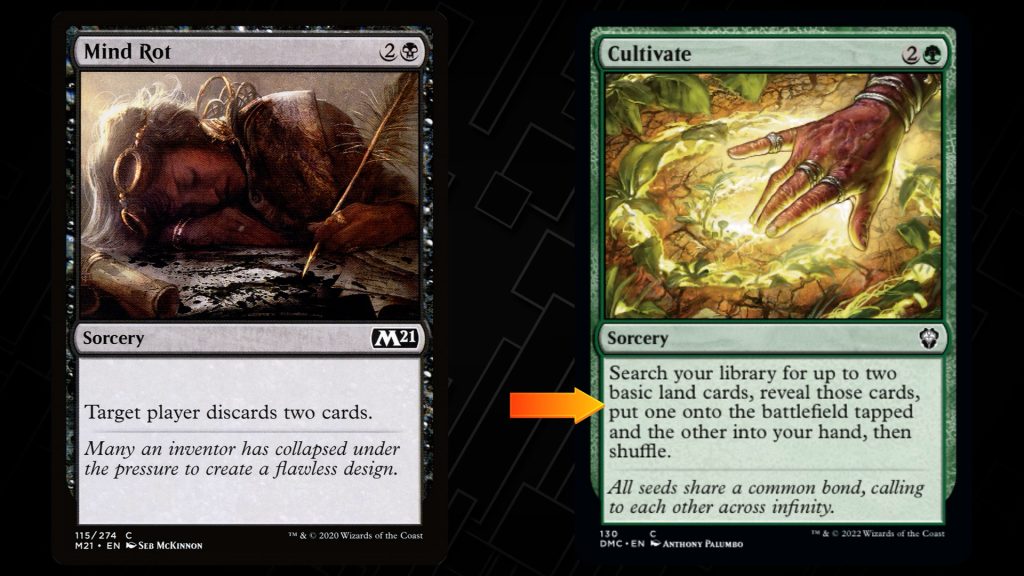
Let’s take a look at some examples of sorceries. When you cast Mind Riot, you target a player, almost always your opponent, and they discard two cards from their hand. Then you put Mind Rot into your graveyard. With Cultivate, you cast it, then follow the directions of the card. Look through your library and find two basic lands, reveal them, and put one onto the battlefield tapped and the other in your hand. Then shuffle your library and place your Cultivate in your graveyard.
Instants
Instants are like sorceries, but you can cast them at any point you have priority. That means you can cast them on your opponent’s turn, in combat, and in response to any spell a player casts. Once you pay an instant’s mana cost and cast it, follow the instructions in the text box of the card, and then put it into the graveyard.
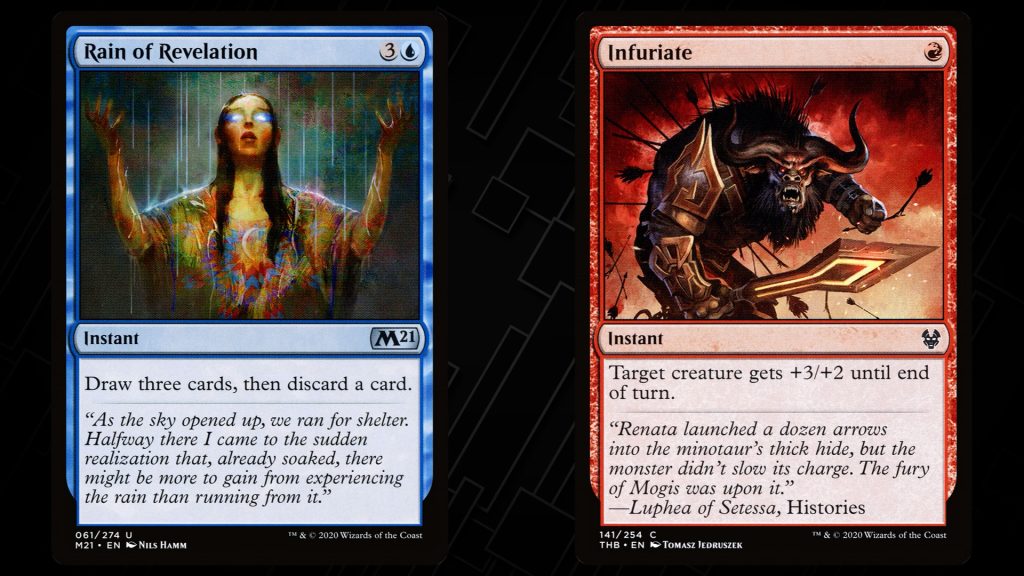
Here are some examples of instants. Rain of Revelation lets you draw three cards and then discard one any time you want for four mana. Infuriate can give a creature +3/+2 whenever you want. If you want to deal more damage in combat, or if someone is trying to kill your creature with damage, you can respond by making your creature large enough to live.
Because instants can be cast at any point you have priority, they’re great for protecting creatures, killing creatures, or stopping other spells. Cancel is the prime example of this. If you are holding Cancel when an opponent casts a spell you don’t want them to have, you can respond with Cancel and counter their spell. When this happens, Cancel and the spell that was countered both go to their owners’ graveyards.
Planeswalkers
Lastly, let’s look at planeswalkers. Planeswalkers are famous characters from the Multiverse whom you can summon to fight by your side on the battlefield.
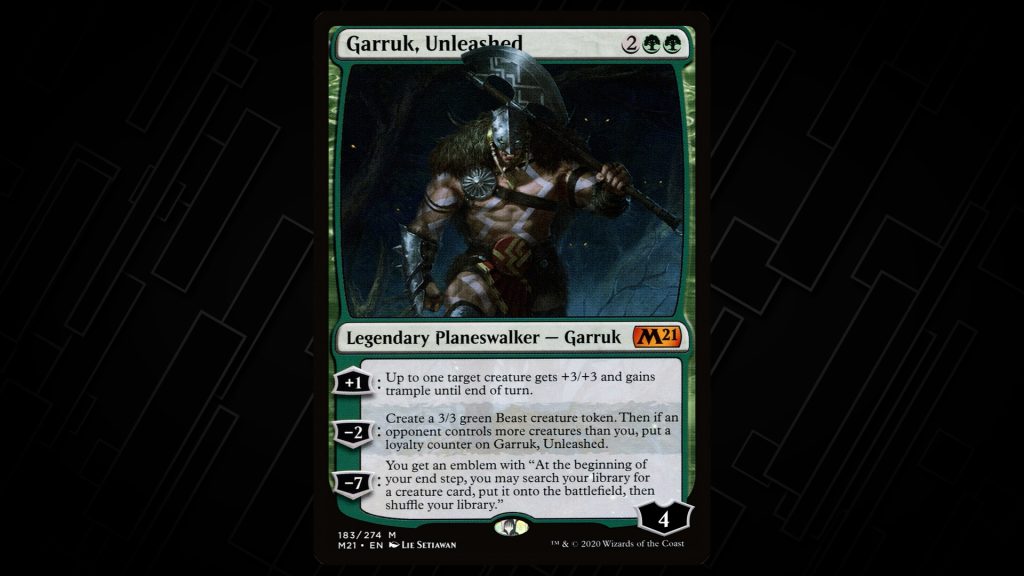
Let’s look at Garruk, Unleashed. Garruk has a name and a mana cost like other permanents, and its type line reads Legendary Planeswalker – Garruk. You can only have one copy of a uniquely named legendary card on your side on the battlefield at a time. You could have a copy of Garruk Relentless and a copy of Garruk Wildspeaker, but if you cast another copy of Garruk Relentless, you’ll have to give up one of them.
In the bottom right, Garruk has a four. This number is how much starting loyalty he has. Loyalty counters are like a planeswalker’s own life total. When Garruk loses all his loyalty, he dies and goes to the graveyard like a creature.
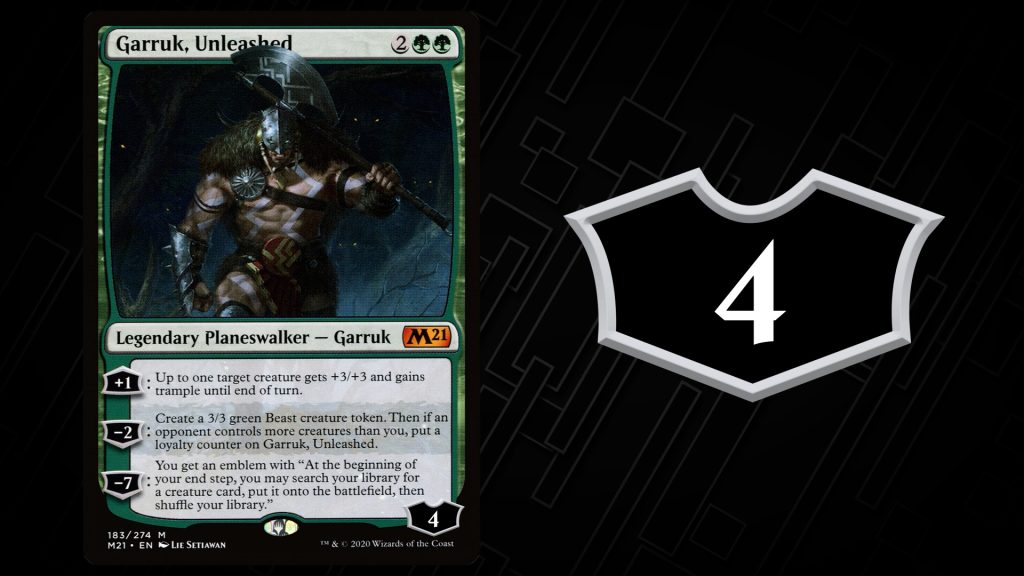
Loyalty counters are more than a planeswalker’s life total, though. They’re also used to activate its abilities. Garruk has three abilities that you can activate on your main phase. You can only activate a planeswalker once per turn on your turn, so choose wisely.
Garruk’s +1 allows you to give a creature +3/+3 and trample until end of turn. Doing this the turn you cast Garruk would increase his loyalty counters up to five.
The -2 ability can only be used if you have at least two or more loyalty. To activate, subtract two loyalty counters from Garruk and make a 3/3 Beast token creature.
Garruk’s ultimate ability requires seven loyalty and gives you his special emblem.
Now, your opponent isn’t going to sit back and let you activate Garruk over and over again without putting up a fight. When players attack with creatures, they can choose to send creatures at your planeswalker. These creatures can be blocked like normal, but if they’re unblocked, they deal their damage to the planeswalker and remove as many loyalty counters as they have power. Players can also send certain damage spells at Planeswalkers as well. How much use you can get out of a planeswalker comes down to how well you protect and how you choose to use it abilities.
Thanks for reading this How To Play Magic: The Gathering article and we hope you found it helpful. Look below for more entries in the series.
Next Article: Steps of a Turn
Previous Article: The Basics

